- Fig. 1 ENOCH SCHULTZ CYPHERING BOOK, 1829, 2010.02.03 and A FRAKTUR DRAWING, 1805, 2006.264.33. Courtesy of the Schwenkfelder Heritage Center, Pennsburg, Pa. Photo Images © DL Moyer
Prior to the year 1897 Fraktur was clearly understood by everyone as an angular broken-lettered calligraphy or typeface. Thereafter an additional meaning was introduced that has redefined the way we think of Pennsylvania Dutch and Moravian material culture. In September of that year Henry Chapman Mercer gave a talk The Survival of the Mediaeval Art of Illuminative Writing Among Pennsylvania Germans to American Philosophical Society members in Philadelphia. Most likely thinking of all the illuminated manuscripts containing both visual decorative elements, and Fraktur script, he suggested that all Pennsylvania German illuminated manuscripts be called Fraktur. However, people came to understand this as nomenclature for objects with or without Fraktur script. Since then, birds, flowers, geometric designs, etc. on paper, textiles, clay, wood, glass, metal, or stone with or without any text can be referred to as Fraktur. The material culture of both groups, therefore, is represented through visual, as well as written Fraktur.
- Fig. 2 COMPARISON OF FRAKTUR WEDDING QUILTS WITH PA DUTCH FRAKTUR DESIGNS, 1820-1840 Courtesy of Moravian Museum of Bethlehem PA M849.01; Winterthur Collection 2000.0071; Schwenkfelder Collection, uncatalogued; Metropolitan Museum of Art, 2016.432.
There are then two kinds of Fraktur quilts: one made up exclusively of blocks signed in Fraktur script; [1] and Fraktur quilts whose central owner/maker block is the only block to be embroidered with initials or name and date in Fraktur script, the remainder being pieced, embroidered or appliquéd with decorative motifs used by the Pennsylvania Dutch in all their media, and commonly called Fraktur. Most frequently seen on illuminated manuscripts, textiles and tombstones, they include geometric designs, doves, pelicans, peacocks, tulips, carnations, pomegranates, trees, stars, and so forth.
Members of the Schleifer-Kichlein family, (Küchlein, Kickline) created four such quilts using Fraktur script, and decorative elements associated with the material culture of the Pennsylvania Dutch, as well as, amazingly enough, embroidering in the center of two of these quilts a tambour worked [2] scene of the latest in fashion design for men, women, and children among both the American English-speaking society, and the well-dressed European family of the 1820s and 1830s.
- Fig. 3 FRAKTUR MOTIFS QUILT, INITIALED “E K 1829” Taken from John Joseph Stoudt . Pennsylvania German Folk Art, 1966, p.334.
John Joseph Stoudt in his 1966 Pennsylvania German Folk Art (p. 334) cites possibly the oldest among the quilts, which at that time belonged to Mr. Oliver Lewis Christman, an antiques dealer and florist living in Pottstown, Pa. One of its blocks is initialed in Fraktur script “E K 1829”. A pieced reel design, along with tambour embroidered Fraktur motifs such as two birds flanking a tulip tree, and French-knotted cherry trees are similar to those found in three other known quilts: an undated/unsigned quilt and two shams reportedly made by Christina Kichline ca. 1830 (Moravian Museum of Bethlehem, Pa, M849.01 & M849.02-01-02), and two other quilts, one initialed in Fraktur script “E S 1830” (Winterthur Museum collection, 2000.0071) in the center owner/maker’s block, and the other, also embroidered in the center owner/maker’s block, in Fraktur script as “Euphemia Kichlein 1832” (Metropolitan Museum of Art, 2016.432).
- Fig. 4 FRAKTUR MOTIFS WEDDING QUILT & SHAMS ATTRIBUTED TO CHRISTINA KICHLINE, CA. 1830. Courtesy of the Moravian Museum of Bethlehem, Pa., M. 849.01, M. 849.02-01-02.
According to the Church Register of Christ Lutheran Church in Trumbauersville, Pa., Christina Schleifer (1795-1884) was born on 11/30/1795 to Heinrich and Dorothea Schleifer.[3] Per the same records her brother John and she were confirmed in 1811. She was married to Jacob Kichlein (1795-1854), and was the mother of seven children, [4] three of whose death certificates—Charles, [5] John Abraham, [6] and Mary Ann Kichlein Applegate Christine, [7] confirm parentage as Jacob Kichlein and Christina Schleifer. That Christina was Euphemia Kichlein Scholl’s (1819-1884) mother is attested to by the 1880 United States Federal Census for Rock Hill, Bucks County, Pa. in which John Scholl, his wife Euphemia, and mother-in-law Christina Kechline are listed. [8] The Commonwealth of Pennsylvania death certificate for William H. Scholl cites John Scholl and Euphemia Kichline (maiden name) as parents.[9] Jacob Kichlein (1795-1854) was born in Rock Hill, Bucks County, Pa. on 4/9/1795 to Elisabeth Kepler (Köbler), and Johannes Kichlein (1768-1852). The U. S. 1850 Federal Census lists fifty-five year old Jacob Kichline as a tavern keeper in Lower Saucon Township, Northampton County, Pa., and head of a very large household including thirty-two year old Euphemia Kichline. [10] He died in Lower Saucon, Northampton County, Pa. 9/28/1854.[11]
The beautifully embroidered and pieced Fraktur motif quilt and pair of pillow shams, now housed at the Moravian Museum of Bethlehem, Pa., was a gift of Mrs. Vernon Melhado, and was accessioned in May 1939. It is described as a
Quilt of red LeMoyne stars of wool on white cotton. Tambour embroidery in wool yarn of birds, tulips, trees, in blue, red and gold colors. Centerpiece tambour work depicts [a] man, woman [,] and child. Braid on 3 sides finished with fringe edges in red and grey is 4.5 inches long. Backed with white cotton.
The accession report dates the quilt to ca. 1830, noting that Christina Schafer [sic] [Schleifer] Kichline made this as her wedding quilt, having married Jacob Kichlein in 1817 at age 16. N. B. In 1817 she was twenty-two. The aforementioned information, along with a note that she carded the wool that was produced on land owned by the Unangst family near Quaker Hill in Northeast Bethlehem in 1815 comes from the original catalogue card. It is not unusual for facts to become blurred by time and memory. Neither are church records always right, but, as already noted, the official birth and baptismal entry for Christina indicates that she was born in 1795 and baptized in 1796. She would have been sixteen in 1811, the date she was confirmed at Christ Lutheran Church, not 1817, and 35 by 1830 when it is estimated the quilt was made.
This is the work of a skilled needleworker. Christina may, indeed, have made it as a wedding quilt, but not for herself. It was traditional for Pennsylvania Dutch grandmothers, mothers, aunts, sisters to make quilts for young boys and girls in the immediate family as early as age eight or nine for their Aussteuer, i.e. future wedding trousseau. Finished quilts were stored away in dower chests waiting to be given several years hence to the now young man or woman when he/she “went housekeeping.” Christina could have made this quilt for any one of her then living children as a future wedding gift.
- Fig. 5 FRAKTUR MOTIFS WEDDING QUILT, Initialed “E S 1830”. MAKER UNKNOWN Courtesy of Winterthur Museum Collection, Winterthur DE, 2000.0071
A similar quilt, in the Winterthur Museum Textile collection, replaces the LeMoyne stars with a reel pattern. French knotted cherry trees with pomegranates placed on either side alternate with the reel block to form an attractive border that, like the second example, is embellished on three sides with a braided edging finished in red fringe.
- Fig. 6 CLOSE-UP FRAKTUR MOTIF WEDDING QUILT, Initialed “E S 1830”. MAKER UNKNOWN Courtesy of Winterthur Museum Collection, Winterthur DE, 2000.0071
Tambour work beautifully renders two birds flanking a tulip tree with trailing pomegranates, a design that is common to all quilts in varied forms.
- Fig. 7 FRAKTUR MOTIF WEDDING OWNER QUILT BLOCK, Initialed “E S 1830”. MAKER UNKNOWN Courtesy of Winterthur Museum Collection, Winterthur DE, 2000.0071
“E S 1830” is embroidered in Fraktur script on the center owner/maker block, and surrounded by flowering tambour worked tulip vines. At the moment we do not know the maker of this quilt, but can definitely say that it was someone within the Schleifer-Kichlein family.
- Fig. 8 ELISABETH KÖBLER EMBROIDERED TAUFSCHEIN 1830 & HEINRICH EBNER & CO. PRINTED TAUFSCHEIN 1822. Courtesy of the Goschenhoppen Historians, 1971.01.55 & Allentown Art Museum, 2009.006.031.
Although not a quilt, a one-of-a-kind embroidered Taufschein owned by the Goschenhoppen Historians (1971.01.55) [12] is also linked to the embroidery achievements of members of the Schleifer-Kichlein family. It was embroidered by J K in 1830 to commemorate a special moment in the past, the October 9, 1776 birth of Elisabeth Köbler Kichlein, grandmother to Jacob and Christina’s seven children. Atypical for the Pennsylvania Dutch, this is a Taufschein intended to be hung on the wall and shown. Its frame, original to the work, encloses two embroidered pieces: The upper one shows the initials of the maker and date J K 1830 in Fraktur script, and the lower one the birth and baptismal certificate. The needleworker’s choice of decorative elements is an interesting combination of motifs contemporary to her time period such as the putto, angels, and birds from Heinrich Ebner’s printed Taufscheins of the 1820s, along with more traditional Pennsylvania Dutch sampler-like objects such as French-knotted cherry trees, embroidered sleek birds, and creeping tulip and other floral vines to form the border framing the text. The tambour work is not as finely done as in the quilts. The ever present baptismal verses announcing the brevity of life and importance of baptism usually found on printed Taufscheins of the period are noticeably absent from this piece. Although it is still unknown who embroidered it, and for what occasion, perhaps it was a fifty-fourth birthday present for a very special grandmother.
Elisabeth’s parents Jacob and Christina Kerschner Köbler (Kepler, Keppel, Koepler, Käbler, Kebler, Kepple) were married 5/18/1762 [13] in St. Paul’s Evangelical Lutheran Church in Coopersburg, Pa., a church still better known as the Blue Church for the bluish-hued plaster that once covered the outer masonry as insulation and protection.
- Fig. 9 THE “BLUE CHURCH” BY RON PRATT. Courtesy of St. Paul’s Evangelical Lutheran Church or the “Blue Church” of Coopersburg, Pa. Photo courtesy of AlyssumArts © DL Moyer.
All of their children’s birth and baptismal records are in the Blue Church Register: Elisabeth was the fifth child of seven children. Her siblings included Johan Georg (2/23/1763); Johann Jacob (4/4/1765); Johannes (6/5/1771); Maria C. (2/20/1774); Elisabeth (10/9/1776); Andreas (3/16/1779); and Susanna (4/7/1781). According to a will registered in Bucks County on 4/10/1824 under File No. 5388, Volume 10 (1821-1831 wills), pp. 357-359, and probated 3/22/1825, her father Jacob is identified as a yeoman, late of Richland Township, Bucks County, Pa. He sets forth in his last testament how moneys and other assets are to be divided among his beloved wife Christina, children and grandchildren, and appoints Elisabeth’s husband Johannes Kichlein (1768-1852) and Jacob Smith as executors. Johannes and Elisabeth had two children John K. Kichline (8/24/1793-5/7/1865) and Jacob S. Kichline (1795-1854), husband to Christina Schleifer (1795-1884), and father of Euphemia (1819-1884), Jacob (1821-1911), Thomas (1823-1857), Mary Ann (1826-1908), Elizabeth (1832-1890), John Abraham (1835-1907), and Charles (1837-1916). Both Johannes and Elisabeth Kepler Kichline are buried, side by side, at Christ Church, old section in Trumbauersville, Bucks County, Pa., Plot: Row F1, F2.
- Fig. 10 FRAKTUR MOTIF WEDDING OWNER QUILT BLOCK, 1832 ATTRIBUTED TO EUPHEMIA KICHLINE (1819-1884) Courtesy of Metropolitan Museum of Art, NYC, 2016.432. Photo © and courtesy of Patricia Herr.
“Euphemia Kichlein 1832” is embroidered in Fraktur script in the central owner/maker block of the quilt now part of the Metropolitan Museum of Art’s Textile collection. Euphemia was thirteen when this quilt was made. Perhaps an experienced family seamstress and she completed it together, or perhaps, as previously suggested, her grandmother, mother, or aunt created it for her Aussteuer or future wedding trousseau.
- Fig. 11 FRAKTUR MOTIF WEDDING QUILT SECTION, 1832 ATTRIBUTED TO EUPHEMIA KICHLINE (1819-1884) Courtesy of Metropolitan Museum of Art, NYC, 2016.432. Photo © and courtesy of Patricia Herr.
The skillfully executed tambour worked variations of Pennsylvania Dutch bird and tulip tree designs alternate with the pieced reel pattern.
- Fig. 12 FRAKTUR MOTIF WEDDING QUILT FULL-VIEW, 1832 ATTRIBUTED TO EUPHEMIA KICHLINE (1819-1884) Courtesy of Metropolitan Museum of Art, NYC, 2016.432. Photo © and courtesy of Patricia Herr.
The reel pattern is used again in the border, alternating with an angel familiar to those of us who spend time with printed Taufscheins. She balances a bird on her uplifted right hand, and holds a lyre in her left, but shorn of her wings, is now mortal and forever fated to remain on earth.
- Fig. 13 FRAKTUR MOTIF WEDDING QUILT BORDER BLOCK 1832, attributed to Euphemia Kichline (1819-1884), and HEINRICH EBNER TAUFSCHEIN, ca. 1830 Quilt courtesy of Metropolitan Museum of Art, NYC, 2016.432. Photo © and courtesy of Patricia Herr; Taufschein courtesy of Allentown Art Museum, gift of Mr. and Mrs. Arnold Kaplan, 2009, 2009.0060.030. Photo courtesy of AlyssumArts © DL Moyer.
Unlike the winged angel on the Elisabeth Köbler embroidered Taufschein, who still can access celestial realms, the wingless quilt angel, probably copied from a Heinrich Ebner Taufschein of the early 1830s, is destined to walk forever among the tambour worked flowers of this quilt border. Such was the imagination and will of its designer and maker.
- Fig. 14 STYLISH CLOTHING STYLES 1820-1840 IN CENTER QUILT BLOCK Courtesy of MMA Fashion Plates 064, 034, 046; FLP 1068.18.29; Moravian Museum of Bethlehem M849.01
The Moravian Museum of Bethlehem and Metropolitan Museum of Art quilts feature in their center a strolling couple with a young boy. The man, woman, and child are worked in tambour stitch and boast the fashionable styles worn in the 1820s and 1830s by both discerning English-speaking Americans, as well as trendsetting Europeans. Tulip vines and flowers create an arbor-like frame around the scene. Such an addition to quilts principally embellished with Pennsylvania Dutch inspired stars, birds, wingless angels, tulip trees, and pomegranates is unique and quite unexpected. However, if we turn to three fashion plates of the period taken from the Metropolitan Museum of Art’s Costume Institute Fashion Plates: 1800-1866, [14] we can see the similarity in dress and perhaps the inspiration for the figures on the quilts. Also, Henry Young’s 1829 Fraktur drawing of “Miss Catherine McKnight her Picter in the year 1829” shows us an example of the fashion and style of the time in which the quilts were made. Local sources would have included newspapers, and the extremely popular Godey’s Lady’s Book, a magazine founded by Louis Godey in Philadelphia in 1830 with monthly detailed descriptions of the latest in modish clothing and hand-colored fashion plates.
- Fig. 15 METROPOLITAN MUSEUM OF ART FASHION PLATE, Courtesy of the Metropolitan Museum of Art Fashion Plate 034, and FRAKTUR MOTIF WEDDING OWNER QUILT BLOCK, 1832, attributed to Euphemia Kichline (1819-1884) Courtesy of Metropolitan Museum of Art, NYC, 2016.432. Photo © and Courtesy of Patricia Herr.
Although the Schleifer-Kichlein family’s roots were firmly anchored in Pennsylvania Dutch customs, they were also tavern keepers; served the general public; and participated in the contemporary life of the 1820s and 1830s. It was a time of vast change in America. Young people were crossing cultural boundaries, and even as today, merging and blending different cultural milieus. So, perhaps embroidering clothing advertisements directed at English-speaking Americans onto the center of two quilts family needleworkers had otherwise embellished with traditional decorative Fraktur motifs, was an artistic and creative way to express the acculturation of the time period, featuring what was precious from the past while introducing the lifestyle of the present.
ENDNOTES
[1] For more detailed information on this type of Fraktur quilt, see Pennsylvania German Blog Post Nr. 8: Friendship-Fraktur-Signature Quilts.
[2] Tambour work is a needlework form that derived its name from the drum-shaped frame used to stretch the fabric. Instead of a needle, a tiny hook draws a loop of thread from below the fabric to the surface. Reinserting the hook and repeating this operation produces a chain stitch much faster than using a needle.
[3] Christina Schleifer (1795-1884) Christ Lutheran Church Register, Trumbauersville, Pa.: Births/Baptisms, p. 20, accessed 24 August 2016 http://tinyurl.com/zu8jmjn & Namen der Confirmanten vom Jahr 1811. accessed 24 August 2016 http://tinyurl.com/jlf6ygt
[4] Jacob Kichline’s and Christina Schleifer’s children include: Euphemia (1819-1884) , Jacob (1821-1911), Thomas (1823-1857), Mary Ann (1826-1908), Elizabeth (1832-1890), John Abraham (1835-1907), Charles (1837-1916).
[5] Charles R. Kichline Commonwealth of Pennsylvania Death Certificate, File N. 17671; Registered No. 9 (born 6/30/1837; died 2/13/1916) Accessed 25 August 2016 http://tinyurl.com/hdkw87a
[6] J.[ohn] A.[braham] Kichline Commonwealth of Pa Certificate of Death, File No. 115188; Registered No. 227 (born 1/30/1835; died 12/17/1907). Accessed 24 August 2016 http://tinyurl.com/hqzdbyl
[7] Mary Ann Kichline Applegate Christine Commonwealth of Pa Certificate of Death, File No. 86431; Registered No. 45 (born 4/24/1826; died 9/10/1908) Accessed 24 August 2016 http://tinyurl.com/guybxju
[8] Christina Schleifer Kichlein (1795-1884 U. S. Federal Census 1880 for Rock Hill, Bucks County, Pa., 22 June 1880 by Joseph a Fluck, p. 41, lines 42-44. Accessed 24 August 2016 http://tinyurl.com/j4zqs75
[9] William H. Scholl (1841-1907) Pennsylvania Death Certificate, File No. 109911, Reg. No. 147. Records of the Pennsylvania Department of Health, Record Group 11. Pennsylvania Historical and Museum Commission, Harrisburg, Pennsylvania. Accessed 24 August 2016. http://tinyurl.com/z2j9fyb
[10] Euphemia Kichlein (1819-1884) U. S. Federal Census 1850 for Saucon Township in Northampton county, Pa., 13 August 1850 by Wm J Brownle, p. 43, lines 40-42. N. B. Jacob Kichlein is listed as a tavern keeper, and Euphemia Kichlein as thirty-two years of age. Accessed 24 August, 2016. http://tinyurl.com/zmrlssr
[11] Jacob Kichlein (1795-1854) Find a Grave. Accessed 24 August 2016. http://tinyurl.com/z9yhdhw
[12] For more detailed information on the Elsabeth Köbler Embroidered Taufschein, see Pennsylvania German Blog Post Nr. 7: The Elisabeth Köbler Embroidered Taufschein.
[13] “Jacob Kepler & Maria Christina Kerschner Marriage Entry 5/18/1762,” in Records of St. Paul’s Lutheran and Reformed Church (Blue Church) in Upper Saucon Township, Lehigh County, Pennsylvania, 1748-1892, edited by Clarence E. Beckel. vol. II, p. 186. Bethlehem, Pa., 1939.
[14] Metropolitan Museum of Art. Thomas J. Watson Library Digital Collections. Costume Institute Fashion Plates: 1800-1866:
Plate 034, public domain. Accessed 7 August 2016
http://libmma.contentdm.oclc.org/cdm/singleitem/collection/p15324coll12/id/11871/rec/36
Plate 046, public domain. Accessed 7 August 2016 http://libmma.contentdm.oclc.org/cdm/singleitem/collection/p15324coll12/id/3851/rec/21
Plate 062, public domain. Accessed 7 August 2016http://libmma.contentdm.oclc.org/cdm/singleitem/collection/p15324coll12/id/3867/rec/53
SOURCES
Sharon P. Angelo et. alia. Quilts: the Fabric of Friendship. Atlgen, Pa.: Schiffer Publishing Ltd. for the York County Heritage Trust, Pa., 2000.
Lucinda R Cawley. “Ihr Teppich: Quilts and Fraktur.” Uncoverings 2004 vol.25,
11- 40.
Mary Ann Kichline Applegate Christine Commonwealth of Pa Certificate of Death, File No. 86431; Registered No. 45 (born 4/24/1826; died 9/10/1908) Accessed 24 August 2016 http://tinyurl.com/guybxju
Russell D. and Corinne P. Earnest. Papers for Birth Dayes: Guide to the Fraktur Artists and Scriveners, East Berlin, Pa.: Russell D. Earnest Associates, 1997. 2nd ed., vol. 1, pp. 287-290.
Linda Eaton. Quilts in a Material World: Selections from the Winterthur Collection. New York: Abrams in association with the Henry Francis du Pont Winterthur Museum, 2007, 68-69.
Patricia Herr. Quilting Traditions. Atlglen, PA: Schiffer Publishing Ltd. for The Heritage Center of Lancaster County, 2000.
Andreas Kachline (1728-1781) Find a Grave. Accessed 24 August 2016
http://www.findagrave.com/cgi-bin/fg.cgi?page=gr&GRid=73730710
Susanna Benner Kachline (1734-1777) Find a Grave Accessed 24 August 2016 http://www.findagrave.com/cgi-bin/fg.cgi?page=gr&GRid=73730729
Jacob Kepler Will probated April 10, 1824 and proved in Bucks County on March 22, 1825 under File No. 5388, Vol. 10, 1821-1841 pp. 357-359, Executors John Kachlein and Jacob Smith; Registrar Samuel Smith. Bucks County (Pennsylvania). Register of Wills; Probate Place: Bucks, Pennsylvania. Accessed 25 August 2016 http://www.pa-roots.org/data/read.php?28,59982 as well as http://tinyurl.com/zablvvh
Christina Schleifer Kichlein (1795-1884)
U. S. Federal Census 1880 for Rock Hill, Bucks County, Pa., 22 June 1880 by Joseph a Fluck, p. 41, lines 42-44. Accessed 24 August 2016 http://tinyurl.com/j4zqs75
_______________ . Find a Grave. Accessed 24 August 2016. http://www.findagrave.com/cgibin/fg.cgi?page=gr&GRid=63231022&ref=acom
Elizabeth Kepler [Köbler] Kichlein (1776-1861) Find a Grave. Accessed 24 August 2016 http://www.findagrave.com/cgi bin/fg.cgi?page=gr&GRid=51926818
Euphemia Kichlein 1832 Fraktur Quilt. Metropolitan Museum of Art Quilt Collection 2016. Accessed 23 August 2016 http://www.metmuseum.org/art/collection/search/717944
Johannes Kichlein (1768-1852) Find a Grave. Accessed 24 August 2016. http://www.findagrave.com/cgi-bin/fg.cgi?page=gr&GRid=51926842
Charles R. Kichline Commonwealth of Pennsylvania Death Certificate, File N. 17671; Registered No. 9 (born 6/30/1837; died 2/13/1916) Accessed 25 August 2016 http://tinyurl.com/hdkw87a
J.[ohn] A.[braham] Kichline Commonwealth of Pa Certificate of Death, File No. 115188; Registered No. 227 (born 1/30/1835; died 12/17/1907). Accessed 24 August 2016 http://tinyurl.com/hqzdbyl
Jacob S. Kichline (1795-1854) Find a Grave. Accessed 24 August 2016 http://www.findagrave.com/cgi-bin/fg.cgi?page=gr&GRid=86545893&ref=acom
Thomas J. Kichline. The Kichlines in America. Manuscript presented at the Northampton County Historical and Genealogical Society of Easton, Pa., January 15, 1926. Accessed 25 August 2016 http://www.kichline.com/documents/archives/kichlinesinamerica.htm
Metropolitan Museum of Art. Thomas J. Watson Library Digital Collections. Costume Institute Fashion Plates: 1800-1866, Plate 034, public domain. Accessed 7 August 2016
http://libmma.contentdm.oclc.org/cdm/singleitem/collection/p15324coll12/id/11871/rec/36
_______________. Thomas J. Watson Library Digital Collections. Costume Institute Fashion Plates: Women 1827-1829, Plate 046, public domain. Accessed 7 August 2016 http://libmma.contentdm.oclc.org/cdm/singleitem/collection/p15324coll12/id/3851/rec/21
_______________. Thomas J. Watson Library Digital Collections. Costume Institute Fashion Plates: Women 1827-1829, Plate 062, public domain. Accessed 7 August 2016http://libmma.contentdm.oclc.org/cdm/singleitem/collection/p15324coll12/id/3867/rec/53
Donald and Nancy Roan. Lest I Shall Be Forgotten: Anecdotes and Traditions of Quilts Green Lane, PA: Goschenhoppen Historians, 1993.
Nancy Roan and Ellen Gehret. ‘Just A Quilt’ or Juscht en Deppich. Green Lane, PA: Goschenhoppen Historians, n.d.
Christina Schleifer (1795-1884) Christ Lutheran Church Register, Births/Baptisms, p. 20, accessed 24 August 2016 http://tinyurl.com/zu8jmjn
_______________. Christ Lutheran Church Register. Namen der Confirmanten vom Jahr 1811. accessed 24 August 2016 http://tinyurl.com/jlf6ygt
Euphemia Kichlein Scholl (1/16/1819-9/6/1884) Find A Grave. Accessed 24 August 2016. http://www.findagrave.com/cgi-bin/fg.cgi?page=gr&GRid=64248403&ref=acom
William H. Scholl (1841-1907) Pennsylvania Death Certificate, File No. 109911, Reg. No. 147. Records of the Pennsylvania Department of Health, Record Group 11. Pennsylvania Historical and Museum Commission, Harrisburg, Pennsylvania. Accessed 24 August 2016. http://tinyurl.com/z2j9fyb
Robert Shaw. American Quilts: The Democratic Art, 1780-2007. New York: Sterling Publishing, 2009, 44-45.
Klaus Stopp. The Printed Birth and Baptismal Certificates of the German Americans, vol.1 of 6. Mainz, Germany and East Berlin, Pa: privately published, 1997-1999.
John Joseph Stoudt. Pennsylvania German Folk Art. Publications of the Pennsylvnia German Folklore Society, vol. 28, Allentown, Pa: Schlechters, 1966, 334.
Winterthur Research Fellow, Moravian and Pennsylvania Dutch Material Culture, 2016
 Every year Winterthur provides fellowships to a select group of scholars for research
in their chosen areas of study in social and cultural history, including material culture, architecture, decorative arts, design, consumer culture, garden and landscape studies, Shaker studies, travel and tourism, the Atlantic World, and objects in literature. ~
Every year Winterthur provides fellowships to a select group of scholars for research
in their chosen areas of study in social and cultural history, including material culture, architecture, decorative arts, design, consumer culture, garden and landscape studies, Shaker studies, travel and tourism, the Atlantic World, and objects in literature. ~
Winterthur Research Program
Thanks to a short-term research fellowship this summer at Winterthur, I have been able to study rare books in the Winterthur Museum Library Collection of Printed Books and Periodicals; objects in the Winterthur Museum Collection; and manuscripts in the Joseph Downs Collection of Manuscripts and Printed Ephemera. All has contributed to my research for a book in progress Heavenly Fraktur: How Fraktur Influenced Pennsylvania German and Moravian Material Culture. This blog post is based on that research. My sincere thank you to all at Winterthur who have made this fellowship possible.
My thanks also to Patricia Herr, Author and Collector; the Rev. James Hammond, and Kathy Exner of St. Paul’s Evangelical Lutheran “Blue Church” of Coopersburg, Pa.; Janine Pollock and Joseph Shemtov of the Rare Book Department at the Free Library of Philadelphia; Joanne Kintner, Pat Gottschalk, Nancy Roan, Linda Szapacs, and Robert Wood of the Goschenhoppen Historians, Inc.; Charlene Donchez, Lindsey Jancay, and Keith Sten of Historic Bethlehem, Inc.; Dorothy McCoach, Independent Textile Conservator; Dave Luz, Candace Perry, and Hunt Schenkel of the Schwenkfelder Library & Heritage Center; Linda Eaton, Tom Guiler, Julia Hofer, Susan Newton, Catharine Roeber, and Roberta Weisberg of Winterthur Museum.
Fraktur Quilts from the Schleifer-Kichlein Family Blog Post 13 including transcriptions; translations; and photo images, except for images of E. S. 1830 Quilt Winterthur Collection 2000.0071; E. K. 1829 ILL. in John Joseph Stoudt Pennsylvania German Folk Art (1966, p. 334); Photo © Patricia Herr Euphemia Kichlein 1832 Quilt; MMA Fashion Plates 064, 034, 046, © 2016 Del-Louise Moyer.

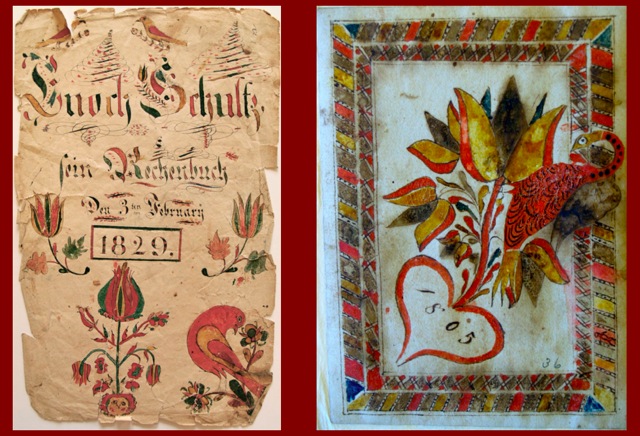

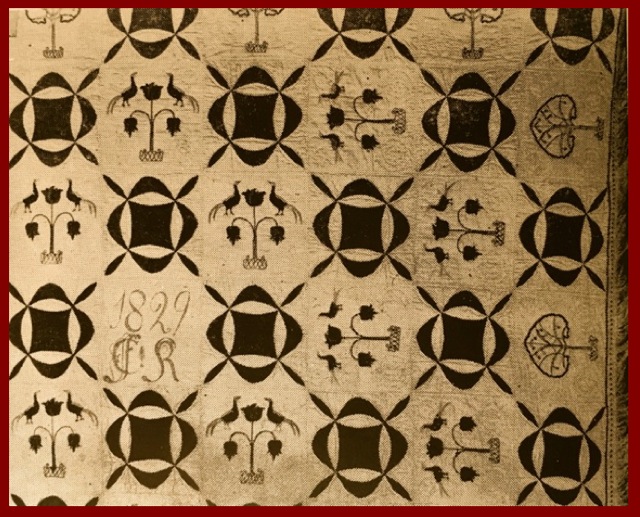
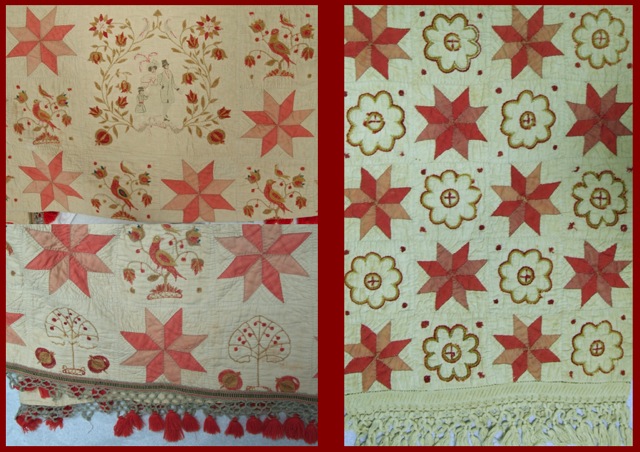
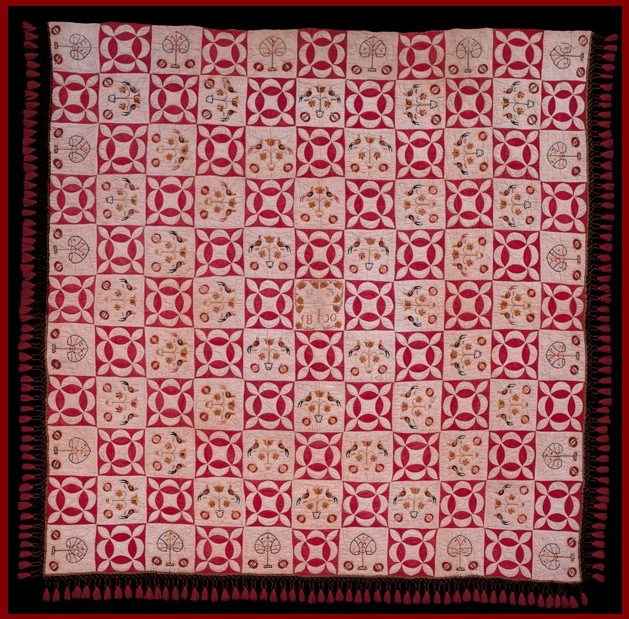


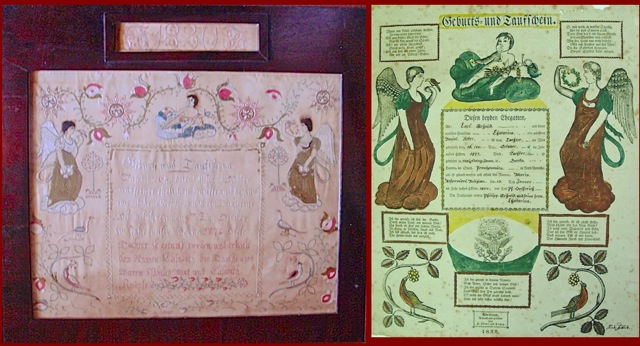

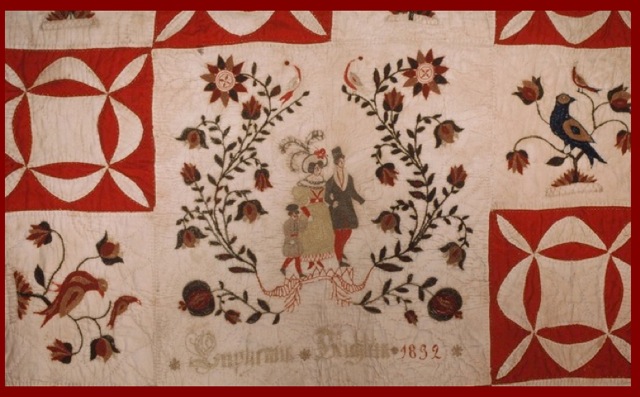
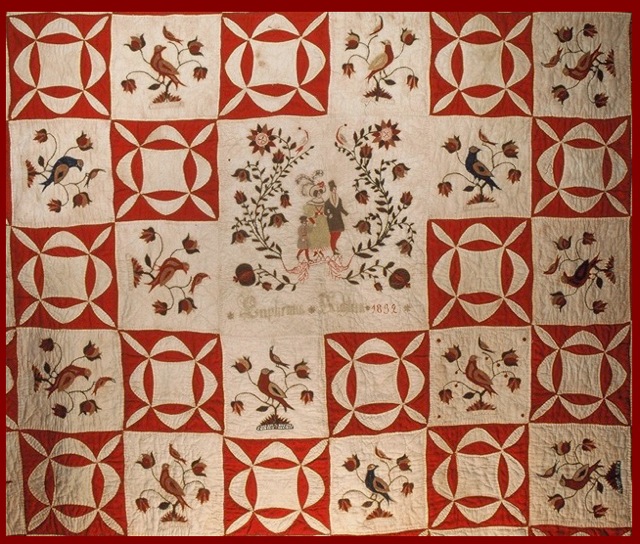
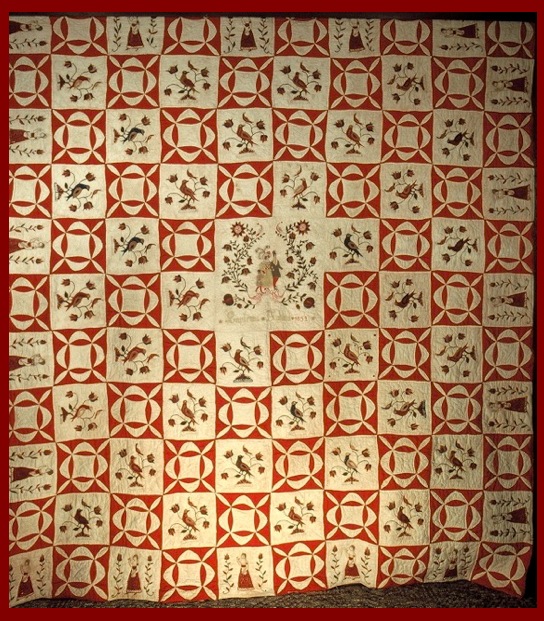
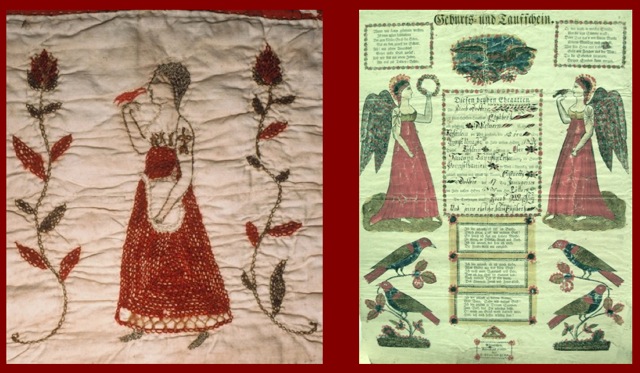

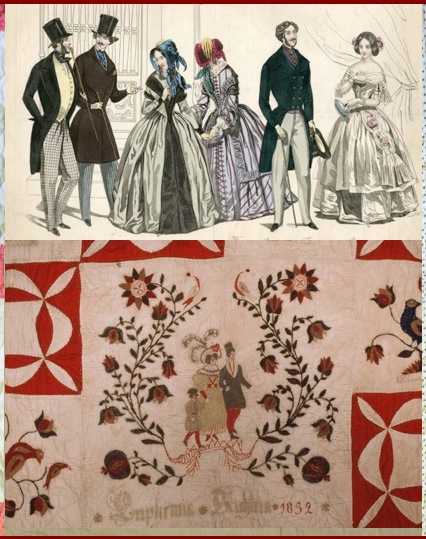
Great article! You really put it all together. We have another related piece for sale on our website theherrsantiques.com It is a pieced and embroidered pillowcase sharing the same motifs and the quilts.
LikeLike
Thank you. They’re beautiful!
LikeLike
A great article and well thought out. I think you have made convincing links to a number of source including fraktur and printed design sources. In many ways, you have gone beyond what Stoudt suggested many years ago to drill down into the origin of this work. Bravo.
LikeLike
Fascinating connections, excellent research & so well-written!
LikeLike
Well, you’ve done it again! What a piece of scholarship…outstanding. Del, I learn so much from your blogs. Thanks for sharing all your work.
LikeLike
Sorry that I have delayed a hearty response to your lovingly erudite treatise on these exquisite pieces of needlework. You relate and explain their values clearly and provide background that brings them to life. Brava!
LikeLike